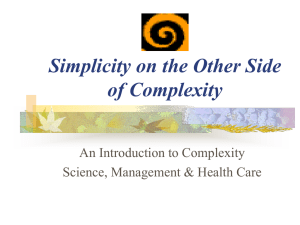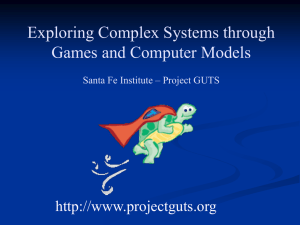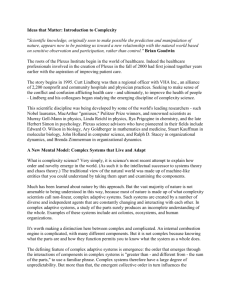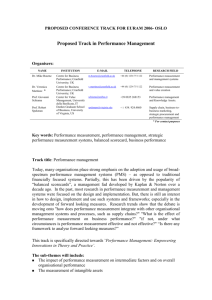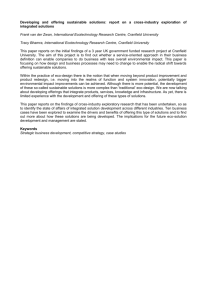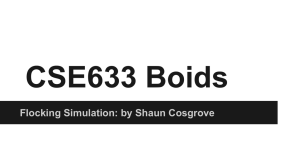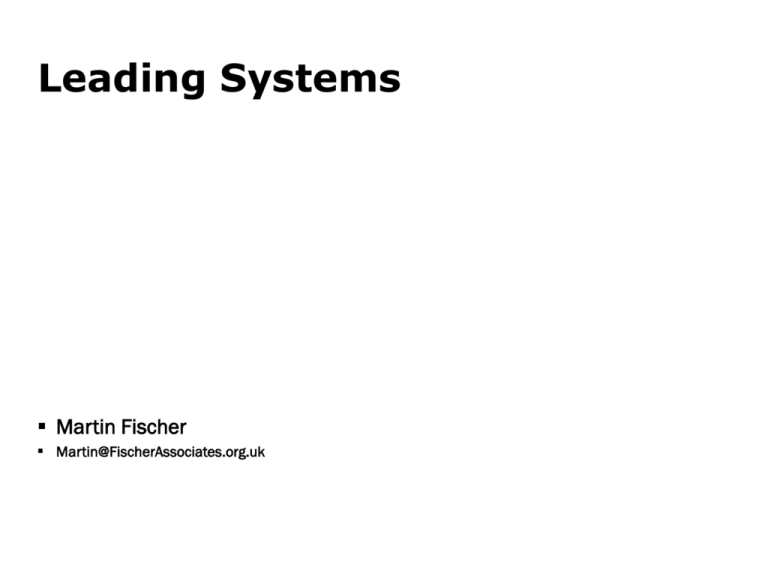
Leading Systems
Martin Fischer
Martin@FischerAssociates.org.uk
It’s not what you don’t know that’s the problem, it’s what you
know that ain’t so.
—Anonymous (American)
The real voyage of discovery is not to travel to distant lands,
but to see with new eyes.
—Proust
Social Construction of Leadership
Leader as source of power (1910)
Leader as designer of system (2000)
2020 leader as:
Systems “regulator/storyteller”?
Keeper of the rules of engagement?
Network “manager”?
Ecologist?
__________________
Origins of Ideas
Courtesy of The General Libraries, The University of Texas at Austin.
Social Construction of Organizational
Structure
Solution
Structure
Managerial Framework
Right people (nepotism)
Court
Mentoring
Bureaucracy
Hierarchy
Procedure
Expertise
Profession
Supervision
Incentives
Corporation
Pay/promotion
Compliance
Regulation
Training/framework
Most Organizations Fail
Average life of S&P firms has fallen
from 65 years (1920 to 1930) to
12 years (2000).
In the last 55 years only 17 firms
survived the period, but all but 1 had
a return on investment less than the
overall market gain.
It seems that companies either fail
rapidly or, if successful, create an
identity and lock into it.
Usually, after some time as a
successful company, performance
weakens, the company is acquired or
it simply ceases operation.
S&P = Standard & Poor’s.
Source: Cranfield University School of Management.
Average Time in S&P List
(Years)
60
50
40
30
20
10
1920 1940 1960 1980 2000
Graphic courtesy of Prof Peter M Allen, Complex Systems Research
Centre, School of Management, Cranfield University.
Leading Systems
Tame (Complicated)
Wicked (Complex)
Environment
Stable
Adaptive
Success
Unambiguous
Multiple perspectives
Process
Predictable
Iterative innovation
Model of the NHS as a system
A model of the healthcare system
NHS Institute for Innovation and Improvement
NHS = National Health Service (UK).
Leaders Historically Focus on Structure
We trained hard, but it seemed that every time we
were beginning to form into teams we would be
reorganised. I was to learn later in life that we tend
to meet any new situation by reorganisation; and a
wonderful method it can be for creating the illusion
of progress while producing confusion, inefficiency
and demoralization.
—Caius Petronius*, AD 66
*Ordered by Nero to commit suicide for being a troublemaker
Complex Adaptive Social Systems
Complex
Nonlinear
relationships
Emergent
properties
Adaptive
Coevolves
over time
Survival of
the fit
Social
System
Conditional
Many semicooperators and
autonomous
altruistic punisher
agents
interacting
Live in language
Systems: Relationship Determines
Outcome
1+1=2
Explanation of Financial Performance
The financial performance of the different plants is strongly correlated
with the human and organisational factors related to the ability to
operate the manufacturing capacity successfully.
The actual manufacturing
capabilities themselves
Correlation MC, H+O and FP
are much less correlated
2.0
Man Cap
1.8
with financial performance.
Human + Org
1.6
1.4
1.2
1.0
0.8
0.6
0.4
0.2
0.0
Financial
Performance
1
2
3
4
5
6
7
8
9
Graphic courtesy of Prof Peter M Allen, Complex Systems Research Centre,
School of Management, Cranfield University.
Source: Cranfield University School of Management.
Systems: Implications for Leadership
Your system works perfectly.
If you don’t like the outcome,
understand how it really works
(from multiple perspectives).
Be ruthless about
relationships.
Complexity: Chaos Game
1,2
3,4
5,6
Rules
1. Put a point anywhere within the triangle.
2. Roll the die.
3. Move to a point halfway between where you are and the
number you rolled.
Complexity: Order From Simple Rules
Complexity: Emergence Brings Order,
Not Control
Complexity of boids arises from the interaction of individual agents (boids)
adhering to a set of 3 simple rules:
1. A boid tries to maintain a minimum distance from other objects in the environment,
including other boids.
2. It tries to match velocities with boids in its neighborhood.
3. It tries to move toward the perceived center of mass of boids in its neighborhood.
There are no rules about forming a flock.
The rules are entirely local, referring
only to what an individual boid can see
and do in its own vicinity.
If a flock forms, it does so from the
bottom up, as an emergent phenomenon.
Source: wikipedia.org.
Complexity: Implications for Leadership
Do not intervene at the level where the issue
manifests itself.
Uncover “rules of thumb” that guide behaviour
(stories).
FBI-Foto
Adaptive
Paul Ormerond modelled the life expectancy of firms under different
hypotheses about their capacity to learn. He found that the model that
fits best corresponds to random extinction and very little learning.
Intelligence lies at the periphery; the role of hierarchy is different.
Example: Infosys
Adaptive: Information and Conflict as a
Source of Energy
All organizations are hungry.
Information and conflict are
great sources of energy.
Therefore leaders ensure:
Open access to information
Conflicts get polarized,
not negotiated
Marks and Spencer
Multiple and diverse
perspectives are heard
Adaptive: Diversity Is the Solution, Not
the Problem
This fictional account of the day-to-day life of an English
gamekeeper is of considerable interest as it contains many
passages on pheasant-raising, the apprehending of
poachers, ways to control vermin, and other chores and
duties of the professional gamekeeper. Unfortunately one is
obliged to wade through many pages of extraneous
material.
—Review of Lady Chatterley's Lover by Ed Zern in
Field and Stream, November 1959
Social
Leadership task:
Possibility, not problem
solving
Affective and rational
Receiver-based
communication
Questions
Asking the proper questions is the central act of transformation.
—Clarissa Pinkola Estes, Women Who Run With the Wolves
Answers are just echoes, they say, but a question travels before it
comes back, and that’s what counts.
—William Stafford, The Darkness Around Us Is Deep:
Selected Poems
A vital question, a creative question, rivets our attention…. Knowledge
emerges in response to these compelling questions.
—Verne Allee, The Knowledge Evolution:
Expanding Organizational Intelligence
Lead the Whole, Not Parts
Mayonnaise
The greatest shock to scientist in the 20th century was the realisation
that you can understand nothing, absolutely nothing, about the whole by
understanding the parts.
—Fritjof Capra, The Web of Life
The Heart: Cardiologist’s (Reductionist)
View
LifeART image copyright © 2001 Lippincott Williams & Wilkins. All rights reserved.
The Heart: More Systemic (Networked)
View
Coupled feedback networks
operating over wide range of
temporal/spatial scales
Limbic
System
ACTH
ADH
Baro-/Chemoafferents
SA
Sympathetic
Nervous
System
Aldosterone
Corticoids
Angiotensin
Epinephrine
Vasoconstriction
LifeART image copyright © 2001 Lippincott Williams & Wilkins. All rights reserved.
Renin
Treating the Whole vs Treating the Part
Treatment of Chronic Heart Failure
Mechanistic (target) approach: increase heart’s pumping
Excess mortality
strength
Milrinone
Vesnarinone
Complexity approach: interrupt vicious neurohormonal
cycle
Beta blockers Enhanced survival
Source: Ary Goldberger, Harvard Medical School.
Leaders Bring Forth the Future Through
Strategy
We have no evidence that any of the strategic planning
systems—no matter how elaborate or how famous—have
succeeded in capturing (let alone improving on) the messy
informal process by which strategies really do get
developed.
—Henry Mintzberg,
The Rise and Fall of Strategic Planning
Strategy in Systems
Strategy as Conversations
We must invent an entirely new approach to the conduct of strategy. Our
most valuable insights will come from beyond traditional strategy
disciplines…at the juncture of emergence, self-organization, cognition
and learning.
The emergence of strategy depends not only on a diversity of voices,
but on the connections between those voices as well.
Strategizing depends on creating a rich and complex web of
conversations that cuts across previously isolated knowledge sets and
creates new and unexpected combinations of insights.
—Gary Hamel, The Search for Strategy
Strategy Is About Necessary Conditions
Beliefs
Guiding principles (rules of thumb, not rules)
Action (autonomy and accountability)
National Health Service (unchanged in 50 years)
Can do should do
Doing means providing treatment.
I’m responsible for the treatment.
Treatment will fix it.
Leadership in ambiguity: relationships, perspectives, attribution
Leaders Know What Counts:
Metrics—You Get What You Measure
Pretax Profits: 1995–2000
£ millions
Marks & Spencer
British Airways
£1,200
£1,000
£800
£600
£400
£200
£0
1994–1995 1994–1995 1996–1996
1996–1997 1997–1998 1999–2000
Which Heart Rate Pattern Is Healthy*?
*Assume comparable activity.
Courtesy of Ary Goldberger, Harvard Medical School.
Some Hallmarks of Healthy, Adaptive
Complexity
Healthy Heart Rate Dynamics
Nonstationarity
Statistics change with time.
Nonlinearity
Components interact in unexpected ways (“cross-talk”).
Multiscale organization
Heart Rate (bpm)
Fluctuations/structures may have fractal organization.
Time (min)
Courtesy of Ary Goldberger, Harvard Medical School.
Transformed Leadership for a
Transformed Health System
Process leader: “[Process] is a
precise technology for the
manipulation of human wisdom and
energy.”
Leaders hold boundaries.
—Maledome Some
Author Benny Gool.
France, Ministère des Affaires
étrangères - Service photographique.
Solution
Right People
(Nepotism)
Structure
Court
Managerial
Framework
Mentoring
Bureaucracy
Hierarchy
Procedure
Expertise
Profession
Supervision
Incentives
Corporation
Pay/Promotion
Compliance
Regulation
Training/Framework
Belonging Together
(Exchange)
Network
Interactive
Conversation

